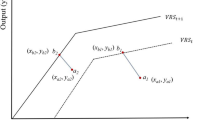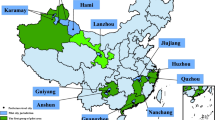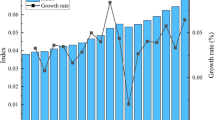Abstract
Urban governance is an important cornerstone in the modernization of a national governance system. The establishment of smart cities driven by digitalization will be a vital way to promote economic green and sustainable growth. By using the data of 274 prefecture-level cities in China from 2004 to 2017, we study the impact of smart city policy on economic green growth and the underlying mechanism of the impact. It is shown that the establishment of smart cities has significantly promoted the green growth of China’s economy. This conclusion is further confirmed by using exogenous geographic data as instrumental variables and robustness tests, such as the quasi-experimental method of Difference in Difference with Propensity Score Matching (PAM-DID). The mechanism test shows that promoting economic growth, reducing per unit GDP energy consumption, and lowering waste emissions represent three ways for smart cities to promote green economic growth. The heterogeneity test shows that smart city policy has an obvious promotional effect on the economic green growth of both large cities and non-resource-based cities. This paper is expected to provide a reference for the urban development and economic transformation of emerging economies.




Similar content being viewed by others
Data availability
The datasets used and/or analyzed during the current study are available from the corresponding author on reasonable request.
Notes
Here, we believe that smart manufacturing, smart management, smart logistics, smart business, and other smart models that involve total economic output are smart production.
References
Acemoglu D, Restrepo P (2018) Modeling automation. AEA Papers and Proceedings 108:48–53
Adapa S (2018) Indian smart cities and cleaner production initiatives – integrated framework and recommendations. J Clean Prod 172:3351–3366
Addanki SC, Venkataraman H (2017) Greening the economy: a review of urban sustainability measures for developing new cities. Sustain Cities Soc 32:1–8
Aghion P, Jones B F, Jones C I (2017) Artificial intelligence and economic growth. National Bureau of Economic Research Working Paper Series No. 23928
Ahad MA, Paiva S, Tripathi G, Feroz N (2020) Enabling technologies and sustainable smart cities. Sustain Cities Soc 61:102301
Ahmed Z, Wang Z, Ali S (2019) Investigating the non-linear relationship between urbanization and CO 2 emissions: an empirical analysis. Air Qual Atmos Health 12(8):945–953
Ahmed Z, Asghar MM, Malik MN, Nawaz K (2020a) Moving towards a sustainable environment: the dynamic linkage between natural resources, human capital, urbanization, economic growth, and ecological footprint in China. Res Policy 67:101677
Ahmed Z, Zafar MW, Ali S (2020b) Linking urbanization, human capital, and the ecological footprint in G7 countries: an empirical analysis. Sustain Cities Soc 55:102064
Albino V, Berardi U, Dangelico RM (2015) Smart cities: definitions, dimensions, performance, and initiatives. J Urban Technol 22:3–21
Allam Z, Dhunny ZA (2019) On big data, artificial intelligence and smart cities. Cities 89:80–91
Andrea C, Chiara D (2018) The economics of smart city policies. Scienze Regionali 17:81–104
Anguluri R, Narayanan P (2017) Role of green space in urban planning: outlook towards smart cities. Urban For Urban Green 25:58–65
Ben Letaifa S (2015) How to strategize smart cities: revealing the SMART model. J Bus Res 68:1414–1419
Black D, Henderson V (1999) A theory of urban growth. J Polit Econ 107(2):252–284
Bradley D, Kim I, Tian X (2016) Do unions affect innovation? Manag Sci 63:2251–2271
Cai X, Lu Y, Wu M, Yu L (2016) Does environmental regulation drive away inbound foreign direct investment? Evidence from a quasi-natural experiment in China. J Dev Econ 123:73–85
Capdevila I, Zarlenga M (2015) Smart city or smart citizens? The Barcelona case. Social Science Electronic Publishing 8(3):266–282
Caragliu A, Del Bo CF (2019) Smart innovative cities: the impact of Smart City policies on urban innovation. Technol Forecast Soc 142:373–383
Chen Y, Ardila-Gomez A, Frame G (2017) Achieving energy savings by intelligent transportation systems investments in the context of smart cities. Transp Res Part D: Transp Environ 54:381–396
De Guimarães JCF, Severo EA, Felix Júnior LA, Da Costa WPLB, Salmoria FT (2020) Governance and quality of life in smart cities: towards sustainable development goals. J Clean Prod 253:119926
Deng Y, Zhang Y (2013) The role of smart city construction in promoting China’s transformation of economic development mode. E-government. 12:2–8
Forrest JYL, Ying YR, Gong ZW (2018) Currency Wars: Offense and Defense through Systemic Thinking. Springer Nature, New York, NY.
Fujita M, Krugman P (1995) When is the economy monocentric?: von Thünen and Chamberlin unified. Reg Sci Urban Econ 25:505–528
Glaeser EL, Kahn ME (2004) Chapter 56 - Sprawl and Urban Growth. In: Henderson, J.V., Thisse, J. (Eds.), Handbook of Regional and Urban Economics, Elsevier 2481-2527
Glaeser E L, Saiz A (2003) The rise of the skilled city. National Bureau of Economic Research Working Paper Series No. 10191
Grazi F, Van den Bergh JCJM (2008) Spatial organization, transport, and climate change: comparing instruments of spatial planning and policy. Ecol Econ 67:630–639
Gu S, Liu J (2012) Urbanization must move from "factor-driven" to "innovation-driven". Population Research 36(06):3–12
Harrison B, Eckman R, Hamilton P, Hartswick J, Kalagnanam J, Paraszczak WP (2010) Foundations for Smarter Cities. IBM J Res Dev 54:41–16
Hayes AF (2009) Beyond Baron and Kenny: statistical mediation analysis in the new millennium. Commun Monogr 76:408–420
Jiang H, Jiang P, Wang D, Wu J (2021) Can smart city construction facilitate green total factor productivity? A quasi-natural experiment based on China’s pilot smart city. Sustain Cities Soc 69:102809
Kirwan C, Fu Z (2020) Smart city business models., pp. 193-215
Kitchin R (2014) The real-time city? Big data and smart urbanism. GeoJournal 79:1–14
Lin B, Tan R (2019) China's economic agglomeration and green economy efficiency. Econ Res 54(02):119–132
Liu X, Sun T, Feng Q (2019) Dynamic spatial spillover effect of urbanization on environmental pollution in China considering the inertia characteristics of environmental pollution. Sustain Cities Soc 53:101903
Nunn N, Qian N (2014) US Food Aid and Civil Conflict. Am Econ Rev 104:1630–1666
Odendaal N (2003) Information and communication technology and local governance: understanding the difference between cities in developed and emerging economies. Comput Environ Urban Syst 27:585–607
Pfeifer A, Prebeg P, Duić N (2020) Challenges and opportunities of zero emission shipping in smart islands: a study of zero emission ferry lines. eTransportation 3:100048
Rahman MM, Alam K (2021) Clean energy, population density, urbanization and environmental pollution nexus: Evidence from Bangladesh. Renew Energy 172:1063–1072
Rode P (2013) Cities and the Green Economy. In: Simpson R, Zimmermann M (eds) The Economy of Green Cities. Local Sustainability, vol 3. Springer, Dordrecht
Romer PM (1986) Increasing Returns and Long-Run Growth. J Polit Econ 94(5):1002–1037
Santra S (2017) The effect of technological innovation on production-based energy and CO2 emission productivity: Evidence from BRICS countries. Afr J Sci Technol Innov Dev 9:503–512
Shen L, Huang Z, Wong SW, Liao S, Lou Y (2018) A holistic evaluation of smart city performance in the context of China. J Clean Prod 200:667–679
Shi C, Shi Q, Guo F (2019) Environmental slogans and action: the rhetoric of local government work reports in China. J Clean Prod 238:117886
Sun M, Zhang J (2020) Research on the application of block chain big data platform in the construction of new smart city for low carbon emission and green environment. Comput Commun 149:332–342
United Nations, Department of Economic and Social Affairs, Population Division (2019). World Urbanization Prospects: The 2018 Revision (ST/ESA/SER.A/420). New York: United Nations
Wang Z, Ahmed Z, Zhang B, Wang B (2019a) The nexus between urbanization, road infrastructure, and transport energy demand: empirical evidence from Pakistan. Environ Sci Pollut R 26:34884–34895
Wang Y, Ren H, Dong L, Park H, Zhang Y, Xu Y (2019b) Smart solutions shape for sustainable low-carbon future: A review on smart cities and industrial parks in China. Technol Forecast Soc 144:103–117
Wendling ZA, Emerson JW, De Sherbinin A, Esty DC, (2020) 2020 Environmental Performance Index. New Haven, CT: Yale Center for Environmental Law & Policy
Xu C, Haase D, Su M, Yang Z (2019) The impact of urban compactness on energy-related greenhouse gas emissions across EU member states: Population density vs physical compactness. Appl Energy 254:113671
Xu N, Ding Y, Guo J (2020) Do Smart City policies make cities more innovative: evidence from China. Journal of Asian Public Policy:1–17
Yang G, Hou Y (2020) The use of industrial robots, technological upgrading and economic growth. Chinese Industrial Economy 10:2–20
Yang W, Li L (2018) Efficiency evaluation of industrial waste gas control in China: A study based on data envelopment analysis (DEA) model. J Clean Prod 179:1–11
Yang D, Wang X, Xu J, Xu C, Lu D, Ye C, Wang Z, Bai L (2018) Quantifying the influence of natural and socioeconomic factors and their interactive impact on PM2.5 pollution in China. Environ Pollut 241:475–483
Yao T, Huang Z, Zhao W (2020) Are smart cities more ecologically efficient? Evidence from China. Sustain Cities Soc 60:102008
Yu Y, Zhang N (2019) Does smart city policy improve energy efficiency? Evidence from a quasi-natural experiment in China. J Clean Prod 229:501–512
Yuan Y, Xie R (2015) FDI, Environmental regulation and China's industrial green total factor productivity growth——an empirical study based on Luenberger index. International Trade Issues 08:84–93
Zhang J, Wu G, Zhang J (2004) China's inter-provincial material capital stock estimation: 1952-2000. Econ Res 10:35–44
Zhang X, Bayulken B, Skitmore M, Lu W, Huisingh D (2018a) Sustainable urban transformations towards smarter, healthier cities: Theories, agendas and pathways. J Clean Prod 173:1–10
Zhang S, Niu T, Wu Y, Zhang KM, Wallington TJ, Xie Q, Wu X, Xu H (2018b) Fine-grained vehicle emission management using intelligent transportation system data. Environ Pollut 241:1027–1037
Zhao W, Yu J (2012) Trade openness, FDI and the growth mode of China’s industrial economy: an empirical study based on data from 30 industrial industries. Econ Res 47(08):18–31
Funding
This study was collectively funded by the National Natural Science Foundation of China [no. 71973068; no. 71803087], Social Science Foundation Major Project of Jiangsu, China [no. 18ZD003]; and Humanities and Social Sciences Research Planning Foundation of China’s Ministry of Education [no. 19YJA790055].
Author information
Authors and Affiliations
Contributions
Yu Qian: methodology, data curation, formal analysis, writing (original draft), writing (review and editing). Jun Liu: conceptualization, writing (review and editing), funding acquisition. Zhonghua Cheng: conceptualization, methodology. Jeffrey Yi-Lin Forrest: writing (review and editing), supervision.
Corresponding author
Ethics declarations
Consent to participate
I am free to contact any of the people involved in the research to seek further clarification and information.
Conflict of interest
The authors declare no competing interests.
Additional information
Responsible Editor: Philippe Garrigues
Publisher’s note
Springer Nature remains neutral with regard to jurisdictional claims in published maps and institutional affiliations.
Rights and permissions
About this article
Cite this article
Qian, Y., Liu, J., Cheng, Z. et al. Does the smart city policy promote the green growth of the urban economy? Evidence from China. Environ Sci Pollut Res 28, 66709–66723 (2021). https://doi.org/10.1007/s11356-021-15120-w
Received:
Accepted:
Published:
Issue Date:
DOI: https://doi.org/10.1007/s11356-021-15120-w




